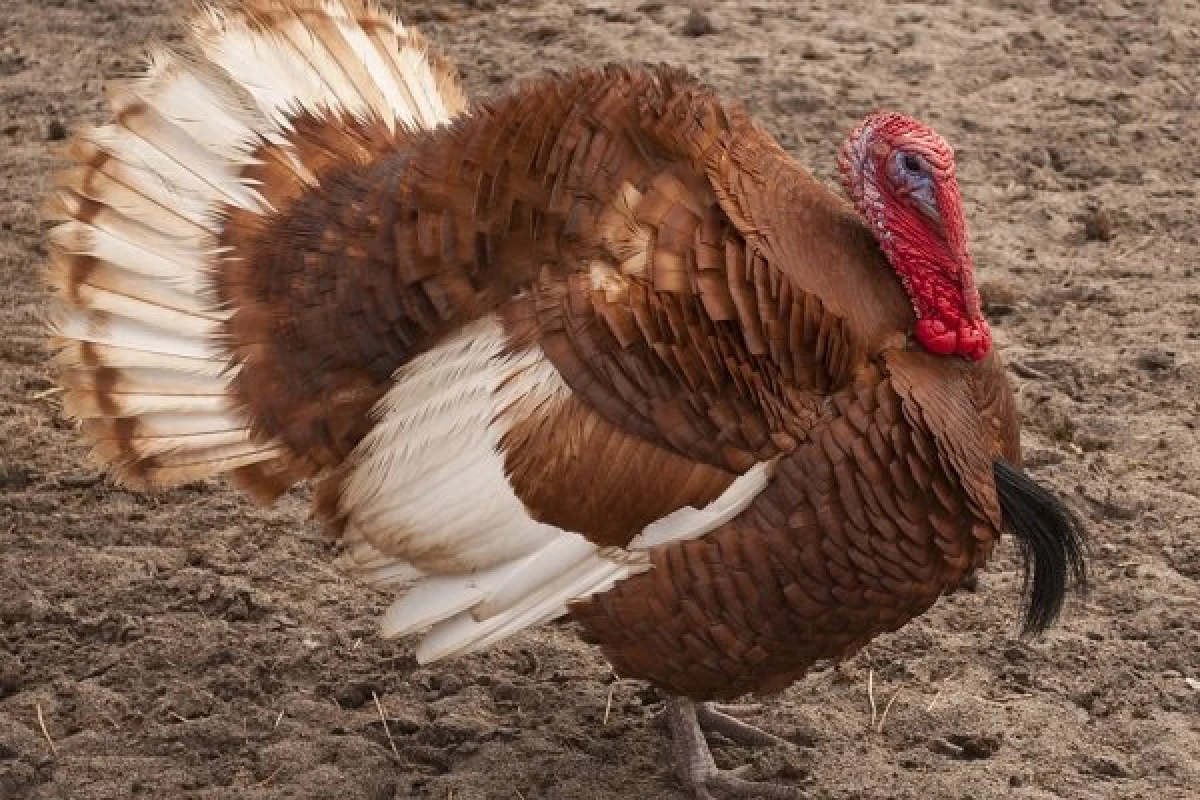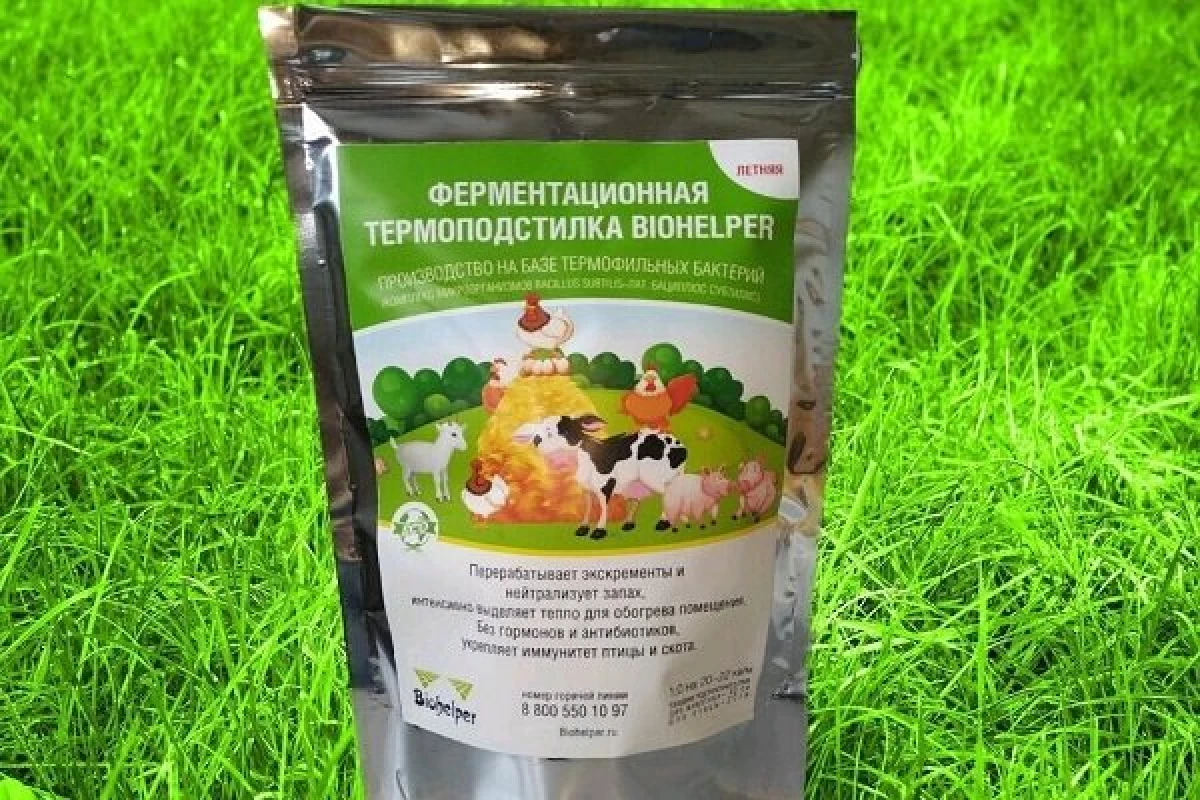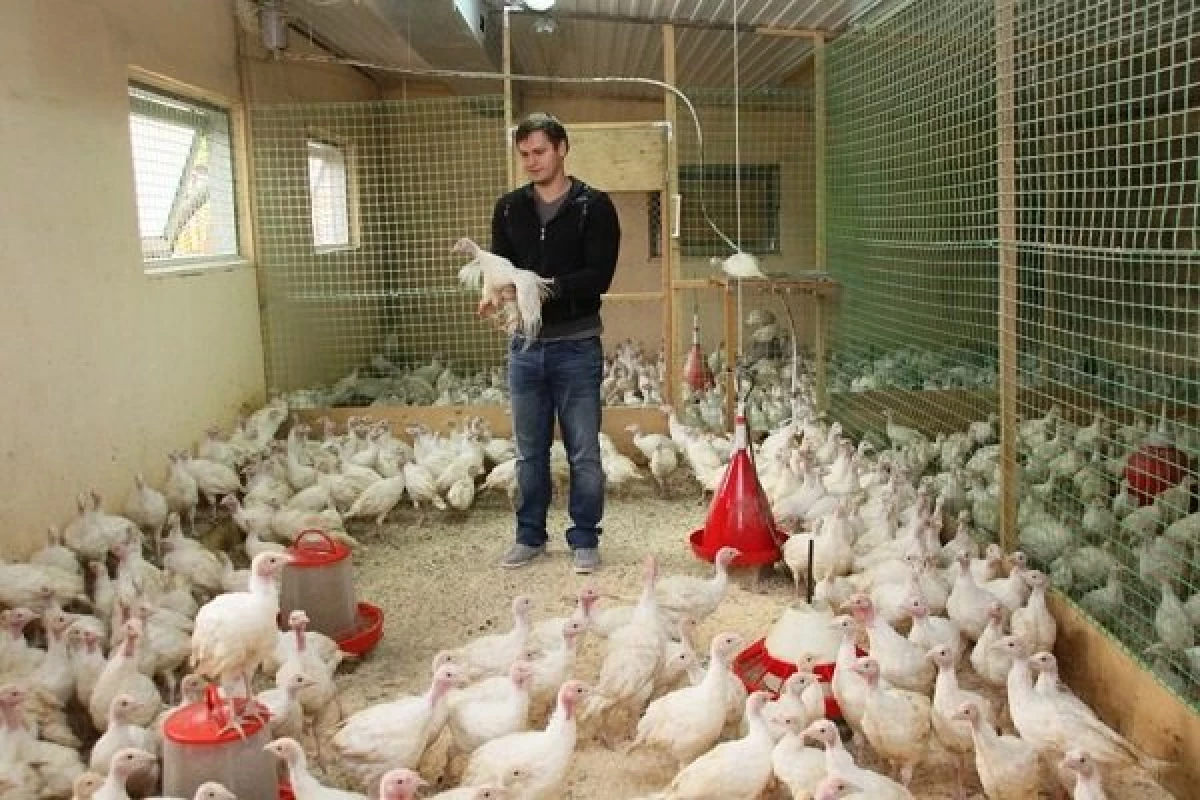Due to the soft and bulk litter, the turret is not only supported cleanliness and order, but also becomes warmer. As a substrate, you can use a variety of materials, including special bacterial compositions, allowing warm floors in the poultry houses.
On the need for turkey bedding
The floor in the turkey is usually made by wooden or mesh, and the thick layer of the litter is put on top of it. It performs several functions at once and can be performed from a variety of materials.

Feet functions:
- absorption moisture and smells;
- Floor insulation;
- depreciation;
- injury protection;
- preventing diseases and infections;
- Clean and dryness.
Two types of bedding are used in the poultry houses:
- Thin. It is poured in the summer, then the floor becomes softer for bird paws, and cleaning is simplified - the litter is easier to rack together with the bulk material than to score from the bare sex.
- Deep. This is an inconvenient litter, the depth of which is at least 20 cm. This option is used in winter and when growing turkey.
The main requirement for the litter - it should be dry and loose. These properties have many materials, so there are many options for arranging the soft layer, consider them in more detail.
Room options
Clean and dry bedding is an indispensable condition for the maintenance of poultry. The material that is used for it should not only approach its physicochemical characteristics for the goal, but also to be accessible and safe.
StrawStraw and hay - cheap and affordable material that is easy to prepare the future. Compared to sawdust, they absorb moisture worse. The raw materials used for the litter is recommended to be pre-crushed, then it will better cope with the tasks.
Long grass can also be used as the upper layer - she is sprinkled by sawdust to prevent eating sawdust in birds if they suddenly find such a tendency.
SawdustThis is, according to the poultry farm, the best bedding material. It absorbs fluids and smells, hovering in the poultry house. Sawdust, swinging, allocate heat even without special fermented additives.
Turkeys are actively digging in sawdust, loose litter and stirring it with litter. In order for the birds even diligently faded in bulk material, many poultry farms throw some grain waste in them.
The main minus sawdust is their high cost. They are beneficial if there is a sawmill and access to cheap raw materials. Such a litter is used only in adult turkeys.
ChipIf there is a wooden processing plant near the poultry house, you can buy wood chips there. This material is not dust and actively absorbs moisture. Its minus is increasing and quite high cost.
PeatThis material takes on the swamps, and it is relevant only where there are peatlands. Peat is recommended to add to sawdust, having previously dried. Unsuccessioned and routine raw materials are not suitable for bedding.
The main plus of peat, which does not have other materials - antiseptic properties. By adding it to other materials, you can prevent diseases in the cold season. Minus - time-consuming blank. Peat gets from the reservoir located under the rod.
SandThe sand perfectly absorbs moisture and smells, which means it may well serve as a bedding. It is soft and less dust than sawdust or chips. This is a cheap and affordable material in which any bird will rumbles with interest.

This is a free material that can be dried in unlimited volumes. Favoring foliage is everywhere where there are shrubs and deciduous trees. Collected fallen leaves are needed in September, in dry weather.
The collected leaves dried and fold into the barn. Before pouring a birchie in the body, her, like hay, you need to finely crushed. Otherwise, they will not absorb moisture with the necessary intensity. The leaves are a seasonal litter, they do not set them all over the year.
Dry Moss.The beautiful litter is obtained from the chopped dry moss of Sfagnum. This plant absorbs water and smells well. This option is relevant where it grows. You can find it in large quantities on swampy terrain.
Moss is recommended to mix with sawdust - to spend it economically. In addition, collecting moss, you need to know the measure - it is impossible to strongly empty the marshes from the moss, it can harm their ecosystem.
NeedlesThis option is good for those farms, near which there is a coniferous forest. Hisua is mined with pine wreath and spruce noodle. They are brought home and wait for the needles to fall. Cheva before use, smallly crushed so that the birds do not paw paw on the sharp ends of the needles.
As part of the needles a lot of volatile substances. They contain essential oils and phytoncides. Having these compounds into the air, the chopped needles have a positive effect on the health of the bird.
Lattice floorsThese plastic flooring for the outdoor maintenance of birds allow you to abandon traditional underfilm raw materials. Have a cellular cell structure. The litter easily falls into the cells.
The coating protects birds from pollution, prevents infecting with viruses and other infections. The floors are assembled from modular decisions of a certain size, for example, 1 x 1 m.
Some poultry farms are trying to use foam plastic as a litter. But specialists do not recommend this option. Birds often opened this soft material, and even eat it, which can lead to their disease and death.
What is a fermentation litter?
It is also called a bacterial bedding. This is a drug containing special enzymes. They are added to the main substrate - the material that will serve throughout the term of the enzymes.
The optimal option for the base is sawdust. They should be at least 70% of the total size of the litter. The remaining 30% is crushed straw, sunflower husk and other vegetable waste.

What materials are not suitable as the basis:
- straw - she has low sorption ability;
- Highly aggregate waste - they are fermented under the influence of enzymes.
There are many fermentation preparations that are distinguished by the period of validity, the requirements for the floor in the poultry house and other characteristics.
Popular brands:
- BioGerm. German drug. Birds can be released 2 hours after use. Allows you to contain a bird at temperatures from -50 ° to +40 ° C. Contains microorganisms, useful for the body of the bird. Service life - 2 years.
- Net reservo2. Domestic tool. It can be used on any floor - wooden, concrete, rubble. Requires regular ventilation - it is necessary to periodically go through. Only for the closed room. Service life - 3 years.
- Bioside3. Another Russian drug. Eco-friendly, strengthens bird health, reduces 10-20% feed consumption. Service life - 3 years.
- Baikal Em-14. This inexpensive domestic drug reduces ammonia concentration. Only for earthlings. Service life - 2 months.
Bacterial bedding is completely safe for birds and man, when they are scattered, do not need protection.
Pluses of biofiders:
- Support heat in the poultry house;
- absorb ammonia;
- Dangerous bacteria destroy;
- Quickly recycle turkey litter, facilitating cleaning, reducing the risks of infection, contributing to cleanliness and order;
- There is no need to have an additional room for collecting avian litter;
- saves weight of time - in contrast to conventional bedding, bacterial is designed for months and even years;
- You can use again - fertilize the garden and garden.
Due to the advantages of fermented bedding, in the end, the productivity of the bird increases, it is better growing and is sick less.
Cons of bacterial litters are practically absent. Is that some poultry farms can embarrass its cost. But it is more than justified by the benefits obtained after applying the means. A good preparation, calculated for 2-3 years, is on average about 3,000 rubles for 20 square meters. m Square.
Fermentation litter need to run correctly. This will depend on the term and efficiency of its use.
Launch order:
- Rinse the floor and wait for him to be good. If you can warm it.
- Sawdust crush on the floor in any convenient way - forks or versions. The thickness of the layer is 30 cm. Over time, the sawdust is compacted to the thickness recommended by the manufacturer.
- Uniform layers of laying the fermented powder on the shakes.
- Pour the litter from the watering can. Water must be clean. Watering chlorinated water is not suitable for this purpose.
- Mix the wet saws thoroughly with the help of Sovka shovel so that the bacteria is evenly distributed throughout the litter.
When to run a bird?
If a regular litter is folded on the floor, then the bird in the poultry industry can be launched immediately after it is distilled. The easiest way to spend an event during the daytime, extinguishing turks to the street.If the litter is treated with fermented biological preparations, it is necessary to wait a certain time to activate the bacteria, and only after that you can start turks. It can be 2-3 hours or 2-3 days - depends on the variety of bacterial agents.
The launch of the bird is produced in the amount specified by the manufacturer - a certain number of heads per 1 kV. m.
Service and care
Run fermented bedding is recommended in September-October. If the process is transferred for winter time, the floors should be preheated.
In the course of operation, the biofielder requires a certain care, as oxygen and nutrition are necessary for bacteria for life and reproduction.
Care Activities:
- Loosening. Once every three days, the litter loose through rake. But these manipulations begin in a week after launching bacteria. If you do not join, bacteria die in time. In order for the birds more actively loose litter, it regularly spread the grain.
- Maintaining a microclimate. In the poultry house there must be high-quality air ventilation, ensuring the maintenance of normal humidity of the litter - no more than 60%. It is measured using a special instrument - a psychrometric hygrometer. With increased humidity, the litter loose and scatter 1 kg of superphosphate per 1 square meter. m. And from above, the layer of sawdust or other material is low.
- Feeding. Bacteria periodically need to feed. For this purpose, a mixture of sugar and enzymes is used - 1000 g and 20 g, respectively, are divorced in 10-20 liters of water. They insist for several hours, and then watered the pre-explosive litter with this composition.

When to change the litter?
If the litter is normal, it is able to maintain its original qualities for 3-4 weeks. In the summer, the old litter is cleaned, in the winter you can retain on top of the fresh layer - such a solution allows you to provide additional heating in the cold season.
A particular case of a biofilament, manufacturers write in the instructions that its service life is 2-3 years. In fact, the action of bacteria weakens gradually, so the poultry products are forced to regularly add fresh enzymes.
Thanks to the biofidestil, the cleaning time in the poulthide is significantly reduced. To get all the advantages provided by such a litter, it needs a certain care. But it takes significantly less time and strength than work related to the replacement of traditional bulk beds.
